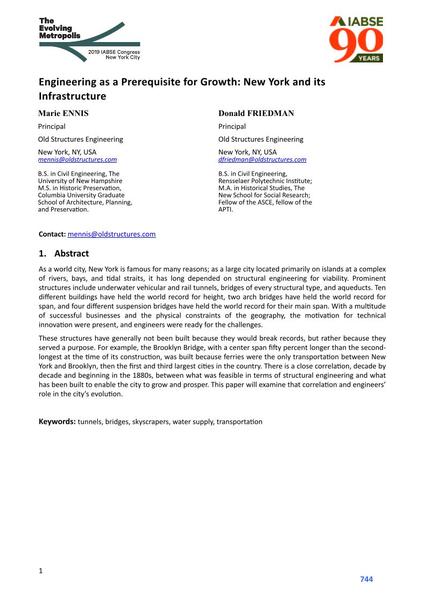Engineering as a Prerequisite for Growth: New York and its Infrastructure

|
|
|||||||||||
Détails bibliographiques
| Auteur(s): |
Marie Ennis
(Old Structures Engineering)
Donald Friedman (Old Structures Engineering) |
||||
|---|---|---|---|---|---|
| Médium: | papier de conférence | ||||
| Langue(s): | anglais | ||||
| Conférence: | IABSE Congress: The Evolving Metropolis, New York, NY, USA, 4-6 September 2019 | ||||
| Publié dans: | The Evolving Metropolis | ||||
|
|||||
| Page(s): | 744-749 | ||||
| Nombre total de pages (du PDF): | 6 | ||||
| DOI: | 10.2749/newyork.2019.0744 | ||||
| Abstrait: |
As a world city, New York is famous for many reasons; as a large city located primarily on islands at a complex of rivers, bays, and tidal straits, it has long depended on structural engineering for viability. Prominent structures include underwater vehicular and rail tunnels, bridges of every structural type, and aqueducts. Ten different buildings have held the world record for height, two arch bridges have held the world record for span, and four different suspension bridges have held the world record for their main span. With a multitude of successful businesses and the physical constraints of the geography, the motivation for technical innovation were present, and engineers were ready for the challenges. These structures have generally not been built because they would break records, but rather because they served a purpose. For example, the Brooklyn Bridge, with a center span fiIy percent longer than the second- longest at the time of its construction, was built because ferries were the only transportation between New York and Brooklyn, then the first and third largest cities in the country. There is a close correlation, decade by decade and beginning in the 1880s, between what was feasible in terms of structural engineering and what has been built to enable the city to grow and prosper. This paper will examine that correlation and engineers’ role in the city’s evolution. |
||||
| Mots-clé: |
ponts tunnel
|
||||
